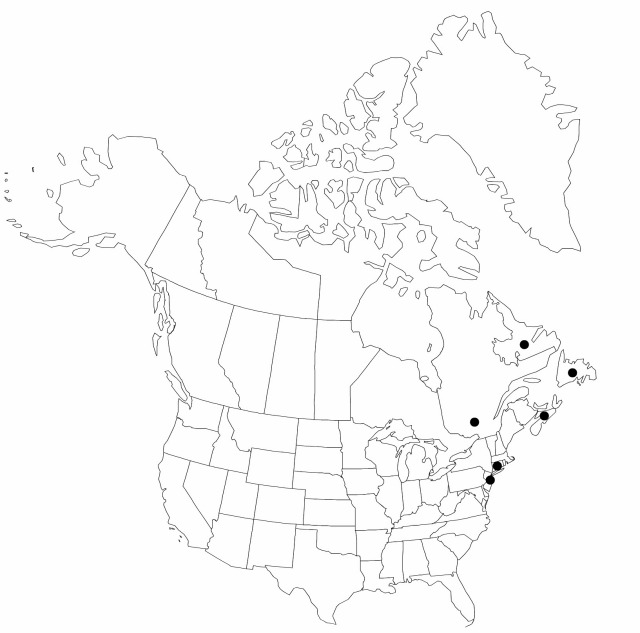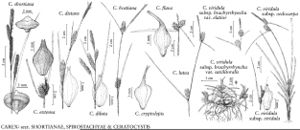Difference between revisions of "Carex viridula subsp. oedocarpa"
Watsonia 14: 316. 1983.
FNA>Volume Importer |
FNA>Volume Importer |
||
| Line 15: | Line 15: | ||
|name=Carex demissa | |name=Carex demissa | ||
|authority=Hornemann | |authority=Hornemann | ||
| − | }}{{Treatment/ID/Synonym | + | }} {{Treatment/ID/Synonym |
|name=Carex tumidicarpa | |name=Carex tumidicarpa | ||
|authority=Andersson | |authority=Andersson | ||
| Line 33: | Line 33: | ||
|elevation=0–200 m | |elevation=0–200 m | ||
|distribution=Nfld. and Labr.;N.S.;Que.;Conn.;N.J.;Europe (from Norway and Finland to Portugal;Italy;and Hungary);Africa (Morocco);Atlantic Islands (Azores;Madeira). | |distribution=Nfld. and Labr.;N.S.;Que.;Conn.;N.J.;Europe (from Norway and Finland to Portugal;Italy;and Hungary);Africa (Morocco);Atlantic Islands (Azores;Madeira). | ||
| − | |discussion=<p>The distribution of Carex viridula subsp. oedocarpa in North America coincides with areas of early European settlement in maritime Canada and northeastern United States. This taxon occurs in natural coastal grasslands in Europe and probably is introduced in North America, where it persists in coastal meadows that were managed as hay fields for colonists’ livestock.</p> | + | |discussion=<p>The distribution of <i>Carex viridula </i>subsp.<i> oedocarpa</i> in North America coincides with areas of early European settlement in maritime Canada and northeastern United States. This taxon occurs in natural coastal grasslands in Europe and probably is introduced in North America, where it persists in coastal meadows that were managed as hay fields for colonists’ livestock.</p> |
|tables= | |tables= | ||
|references= | |references= | ||
| Line 58: | Line 58: | ||
|publication year=1983 | |publication year=1983 | ||
|special status= | |special status= | ||
| − | |source xml=https://jpend@bitbucket.org/aafc-mbb/fna-data-curation.git/src/ | + | |source xml=https://jpend@bitbucket.org/aafc-mbb/fna-data-curation.git/src/8f726806613d60c220dc4493de13607dd3150896/coarse_grained_fna_xml/V23/V23_989.xml |
|genus=Carex | |genus=Carex | ||
|section=Carex sect. Ceratocystis | |section=Carex sect. Ceratocystis | ||
Revision as of 16:12, 18 September 2019
Culms arcuate or slightly sinuous, 10–35 cm. Leaves of flowering stems shorter than to equaling culms, 1.4–4.6 mm wide, ligules of distal cauline leaves usually obsolete. Inflorescences: peduncles of terminal staminate spikes (1–)3–28 mm; proximal pistillate spikes (1–)2–5, approximate, the proximal usually distant and pedunculate, elliptic, 5.3–8.5 mm wide; terminal staminate spikes pedunculate, 9–23.8 × 1.3–3.3 mm. Perigynia dark olive to green, (2.7–)3.2–3.8(–4.2) × 1.1–1.7 mm wide, apex gradually contracted into a smooth or slightly scabrous, straight or slightly curved (less than 28°) beak; beak 0.7–1.7 mm. Achenes 1.1–1.5 × 0.9–1.2 mm.
Phenology: Fruiting Jul–Aug.
Habitat: Moist, open, acidic coastal flats, meadows, not found on lime-rich soils
Elevation: 0–200 m
Distribution

Nfld. and Labr., N.S., Que., Conn., N.J., Europe (from Norway and Finland to Portugal, Italy, and Hungary), Africa (Morocco), Atlantic Islands (Azores, Madeira).
Discussion
The distribution of Carex viridula subsp. oedocarpa in North America coincides with areas of early European settlement in maritime Canada and northeastern United States. This taxon occurs in natural coastal grasslands in Europe and probably is introduced in North America, where it persists in coastal meadows that were managed as hay fields for colonists’ livestock.
Selected References
None.
